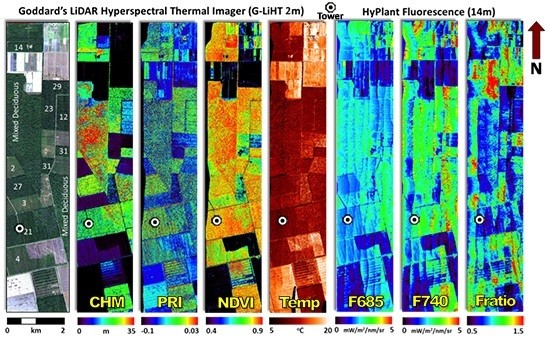The 2013 FLEX—US Airborne Campaign at the Parker Tract Loblolly Pine Plantation in North Carolina, USA
Abstract
:1. Introduction
2. Methods
2.1. Site Description
2.2. Aircraft Instruments
2.2.1. HyPlant
2.2.2. G-LiHT
Airborne Scanning LiDAR
Imaging Spectrometer
Downwelling Radiometer
Thermal Imaging
2.3. Flights and Ground Support
2.4. Data Collections and Data Processing Procedures
2.4.1. Flux Data from the Parker Tract NC2 Tower
2.4.2. HyPlant Data
Preprocessing of HyPlant Data
HyPlant Fluorescence Retrieval
Surface Reflectance from HyPlant
2.4.3. G-LiHT
G-LiHT Thermal Sensor
G-LiHT LiDAR
G-LiHT Headwall VNIR
2.5. Analyses
3. Results
3.1. Data Collections at High Spatial or Stand Level Resolution
3.1.1. The NC2 Flux Tower
3.1.2. Canopy Structure
3.1.3. Thermal Data
3.1.4. Individual Map Products
3.1.5. HyPlant DUAL VSWIR
3.2. Aggregating Data to 49 m2
3.2.1. Fluorescence Group Means for Age Classes and Time Periods
3.2.2. Combining Data Types
4. Discussion
4.1. Fluorescence and the Canopy—Air Temperature Difference
4.2. The PRI
4.3. The Fluorescence Ratio and LUE
4.4. Far-Red vs. Red Fluorescence Radiances
4.5. LiDAR Variables
5. Conclusions
Acknowledgments
Author Contributions
Conflicts of Interest
Abbreviations
| AOI or ROI | spatial Area Of Interest or Region Of Interest |
| ASL | Above Sea Level |
| CHM | Canopy Height Model |
| CCD | Charge-Coupled Device |
| DBH | Diameter was measured at Breast Height |
| DN | Digital Number |
| DTM | Digital Terrain Model |
| EGM96 | Earth Gravitational Model 1996 |
| FOV | Field Of View |
| FLEX | FLuorescence EXplorer |
| FLEX-US | Collaborative ESA/FLEX and NASA/GSFC airborne campaign in the USA |
| GEP | Gross Ecosystem Production |
| G-LiHT | Goddard’s Lidar, Hyperspectral, and Thermal airborne system |
| GSFC | NASA Goddard Space Flight Center |
| GPP | Gross Primary Production |
| GPS | Geographic Positioning System |
| HyspIRI | Hyperspectral InfraRed Imager |
| INS | Inertial Navigation System |
| LAI | Leaf Area Index |
| LaRC | NASA Langley Research Center |
| LiDAR | Light Detection And Ranging |
| LP | Loblolly Pine |
| LUE | Light Use Efficiency |
| LWIR | LongWave InfraRed |
| MERIS | Medium Resolution Imaging Spectrometer |
| MIR | Middle InfraRed |
| MTCI | MERIS Terrestrial Chlorophyll Index |
| NC | North Carolina (USA) |
| NDVI | Normalized Difference Vegetation Index |
| NEP | Net Ecosystem Production and ecosystem respiration |
| NIR | Near InfraRed |
| NIST | US National Institute of Standards and Technology |
| NETD | Noise Equivalent Temperature Difference |
| PARi | incident Photosynthetically Active Radiation |
| PRI | Photochemical Reflectance Index |
| RGB | Red Green Blue |
| ROI | Region Of Interest |
| SEM | Standard Error of the Mean |
| SD | Standard Deviation |
| SIF | Solar-Induced chlorophyll Fluorescence |
| SNR | Signal to Noise Ratio |
| SV | Singular Vector |
| SVD | Singular Vector Decomposition method |
| SWIR | ShortWave InfraRed |
| SZA | Solar Zenith Angle |
| TChl | Total canopy Chlorophyll |
| TIN | Triangulated Irregular Network |
| VDR | Vertical Distribution Ratio (VDR) |
| VNIR | Visible to Near InfraRed |
| VSWIR | Visible to ShortWave InfraRed |
References
- Drusch, M.; Moreno, J.; del Bello, U.; Franco, R.; Goulas, Y.; Huth, A.; Kraft, S.; Middleton, E.; Miglietta, F.; Mohammad, G.; et al. The Fluorescence EXplorer (FLEX) Mission Concept—ESA’s Earth Explorer 8 (EE8). IEEE Trans. Geosci. Remote Sens. 2017, 55, 1273–1284. [Google Scholar] [CrossRef]
- European Space Agency (ESA). Report for Mission Selection; FLEX, ESA SP-1330/2 (2 Volume Series); European Space Agency: Noordwijk, The Netherlands, 2015. [Google Scholar]
- Rascher, U.; Alonso, L.; Burkart, A.; Cilia, C.; Cogliati, S.; Colombo, R.; Damm, A.; Drusch, M.; Guanter, L.; Hanus, J.; et al. Sun-induced fluorescence—A new probe of photosynthesis: First maps from the imaging spectrometer HyPlant. Glob. Chang. Biol. 2015, 21, 4673–4684. [Google Scholar] [CrossRef] [PubMed]
- Cook, B.D.; Corp, L.A.; Nelson, R.F.; Middleton, E.M.; Morton, D.C.; McCorkel, J.T.; Masek, J.G.; Ranson, K.J.; Ly, V.; Montesano, P.M. NASA Goddard’s Lidar, Hyperspectral and Thermal (G-LiHT) airborne imager. Remote Sens. 2013, 5, 4045–4066. [Google Scholar] [CrossRef]
- Corp, L.; Middleton, E.; Cook, B.; Campbell, P.; Huemmrich, F.; Rasher, U.; Pinto, F. Airborne Remote Sensing to Define Ecosystem Form & Function over a Loblolly Pine Plantation. In Proceedings of the International Geoscience and Remote Sensing Symposium (IGARSS15), Milan, Italy, 26–31 July 2015. [Google Scholar]
- Corp, L.A.; Cook, B.D.; McCorkel, J.; Middleton, E.M. Data products of NASA Goddard’s LiDAR, Hyperspectral, and Thermal Airborne Imager (G-LiHT). In Proceedings of the SPIE DSS Defense, Security, and Sensing Symposium, Baltimore, MD, USA, 20–24 April 2015; p. 12. [Google Scholar]
- Forschungszentrum. FLEX-US Final Report, Technical Assistance for the Deployment of the Airborne HyPlant Imaging Spectrometer during 2013 ESA/NASA Joint FLEX-US (FLuorescence EXplorer Experiment in USA) Ampaign; Forschungszentrum: Jülich, Germany, 2015. [Google Scholar]
- Noormets, A.; McNulty, S.G.; Gavazzi, M.J.; Sun, G.; Domec, J.C.; King, J.; Chen, J. Response of carbon fluxes to drought in a coastal plain loblolly pine forest. Glob. Chang. Biol. 2009, 16, 272–287. [Google Scholar] [CrossRef]
- Noormets, A.; McNulty, S.G.; Domec, J.C.; Gavazzi, M.; Sun, G.; King, J.S. The role of harvest residue in rotation cycle carbon balance in loblolly pine plantations. Respiration partitioning approach. Glob. Chang. Biol. 2012, 18, 3186–3201. [Google Scholar] [CrossRef]
- Rossini, M.; Nedbal, L.; Guanter, L.; Ač, A.; Alonso, L.; Burkart, A.; Cogliati, S.; Colombo, R.; Damm, A.; Drusch, M.; et al. Red and far red Sun-induced chlorophyll fluorescence as a measure of plant photosynthesis. Geophys. Res. Lett. 2015, 42, 1632–1639. [Google Scholar] [CrossRef]
- G-LiHT Web Site. Available online: http://gliht.gsfc.nasa.gov/ (accessed on 4 May 2017).
- G-LiHT White Paper. Available online: https://gliht.gsfc.nasa.gov/specs/ (accessed on 4 May 2017).
- Goulden, M.L.; Winston, G.C.; McMillan, A.; Litvak, M.E.; Read, E.L.; Rocha, A.V.; Elliot, J.R. An eddy covariance mesonet to measure the effect of forest age on land–atmosphere exchange. Glob. Chang. Biol. 2006, 12, 2146–2162. [Google Scholar] [CrossRef]
- Guanter, L.; Frankenberg, C.; Dudhia, A.; Lewis, P.E.; Gómez-Dans, J.; Kuze, A.; Suto, H.; Grainger, R.G. Retrieval and global assessment of terrestrial chlorophyll fluorescence from GOSAT space measurements. Remote Sens. Environ. 2012, 121, 236–251. [Google Scholar] [CrossRef]
- Guanter, L.; Rossini, M.; Colombo, R.; Meroni, M.; Frankenberg, C.; Lee, J.-E.; Joiner, J. Using field spectroscopy to assess the potential of statistical approaches for the retrieval of sun-induced chlorophyll fluorescence from space. Remote Sens. Environ. 2013, 133, 52–61. [Google Scholar] [CrossRef]
- Berk, A.; Conforti, P.; Hawes, F. An accelerated line-by-line option for MODTRAN combining on-the-fly generation of line center absorption with 0.1 cm−1 bins and pre-computed line tails, 21 May 2015. Proc. SPIE 2015. [Google Scholar] [CrossRef]
- Berk, A.; Conforti, P.; Kennett, R.; Perkins, T.; Hawes, F.; van den Bosch, J. MODTRAN6: A major upgrade of the MODTRAN radiative transfer code, 13 June 2014. Proc. SPIE 2014. [Google Scholar] [CrossRef]
- Richter, R.; Schläpfer, D. Atmospheric/Topographic Correction for Airborne Imagery; DLR Report DLR-IB 565-02/15; DLR: Wessling, Germany, 2015; p. 254. [Google Scholar]
- Schläpfer, D.; Richter, R.; Feingersh, T. Operational BRDF Effects Correction for Wide-Field-of-View Optical Scanners (BREFCOR). IEEE TGARS 2015, 53, 1855–1864. [Google Scholar] [CrossRef]
- G-LiHT List of Plot Scale Metrics. Available online: ftp://fusionftp.gsfc.nasa.gov/multimedia/docs/metrics_readme.pdf (accessed on 4 May 2017).
- Lee, C.M.; Cable, M.L.; Hook, S.J.; Green, R.O.; Ustin, S.L.; Mandl, D.J.; Middleton, E.M. An introduction to the NASA Hyperspectral InfraRed Imager (HyspIRI) mission and preparatory activities. Special Issue on HyspIRI. Remote Sens. Environ. 2015, 167, 6–19. [Google Scholar] [CrossRef]
- Gamon, J.A.; Peñuelas, J.; Field, C.B. A narrow-wavelength spectral index that tracks diurnal changes in photosynthetic efficiency. Remote Sens. Environ. 1992, 41, 35–44. [Google Scholar] [CrossRef]
- Gamon, J.A.; Serrano, L.; Surfus, J.S. The photochemical reflectance index: An optical indicator of photosynthetic radiation use efficiency across species, functional types, and nutrient levels. Oecologia 1997, 112, 492–501. [Google Scholar] [CrossRef] [PubMed]
- Filella, I.; Amaro, T.; Araua, J.L.; Peñuelas, J. Relationship between photosynthetic radiation-use efficiency of barley canopies and the photochemical reflectance index (PRI). Physiol. Plant. 1996, 96, 211–216. [Google Scholar] [CrossRef]
- Rouse, J.W.; Haas, R.H.; Scheel, J.A.; Deering, D.W. Monitoring vegetation systems in the Great Plains with ERTS. In Proceedings of the 3rd Earth Resource Technology Satellite (ERTS) Symposium, Washington, DC, USA, 10–14 December 1973. [Google Scholar]
- Tucker, C.J. Red and Photographic Infrared Linear Combinations for Monitoring Vegetation. Remote Sens. Environ. 1979, 8, 127–150. [Google Scholar] [CrossRef]
- Dash, J.; Curran, P.J. Evaluation of the MERIS terrestrial chlorophyll index (MTCI). Adv. Space Res. 2007, 9, 100–104. [Google Scholar] [CrossRef]
- Dash, J.; Curran, P.J.; Tallis, M.J.; Llewellyn, G.M.; Taylor, G.; Snoeij, P. Validating the MERIS Terrestrial Chlorophyll Index (MTCI) with ground chlorophyll content data at MERIS spatial resolution. Int. J. Remote Sens. 2010, 31, 5513–5532. [Google Scholar] [CrossRef]
- Lichtenthaler, H.K.; Rinderle, U. The role of chlorophyll fluorescence in the detection of stress conditions in plants. CRC Crit. Rev. Anal. Chem. 1988, 19, S29–S85. [Google Scholar] [CrossRef]
- Agati, G.; Mazzinghi, P.; Fusi, F.; Ambrosini, I. The F685/F730 chlorophyll fluorescence ratio as a tool in plant physiology: Response tophysiological and environmental factors. J. Plant Physiol. 1995, 145, 228–238. [Google Scholar] [CrossRef]
- Porcar-Castell, A.; Tyystjärvi, E.; Atherton, J.; van der Tol, C.; Flexas, J.; Pfündel, E.E.; Moreno, J.; Frankenberg, C.; Berry, J.A. Linking chlorophyll a fluorescence to photosynthesis for remote sensing applications: Mechanisms and challenges. J. Exp. Bot. 2014, 65, 4065–4095. [Google Scholar] [CrossRef] [PubMed]
- Cheng, Y.-B.; Middleton, E.M.; Zhang, Q.; Huemmrich, K.F.; Campbell, P.K.; Corp, L.A.; Cook, B.D.; Kustas, W.P.; Daughtry, C.S. Integrating Solar Induced Fluorescence and the Photochemical Reflectance Index for Estimating Gross Primary Production in a Cornfield. Remote Sens. 2013, 5, 6857–6879. [Google Scholar] [CrossRef]
- Rossini, M.; Meroni, M.; Celesti, M.; Cogliati, S.; Julitta, T.; Panigada, C.; Rascher, U.; van der Tol, C.; Colombo, R. Analysis of Red and Far-Red Sun-Induced Chlorophyll Fluorescence and Their Ratio in Different Canopies Based on Observed and Modeled Data. Remote Sens. 2016, 8, 412. [Google Scholar] [CrossRef]
- Colombo, R.; Celesti, M.; Campbell, P.; Cogliati, S.; Cook, B.; Corp, L.A.; Damm, A.; Guanter, L.; Julitta, T.; Middleton, E.M.; et al. On the variability of sun-induced chlorophyll fluorescence according stand age related processes in a loblolly pine forest. Remote Sens. Environ. 2017. in review. [Google Scholar]
- Middleton, E.M.; Cheng, Y.-B.; Campbell, P.E.; Huemmrich, K.F.; Corp, L.A.; Bernardes, S.; Zhang, Q.; Landis, D.R.; Kustas, W.P.; Daughtry, C.S.T.; et al. Multi-angle hyperspectral observations with SIF and PRI to detect plant stress & GPP in a cornfield. In Proceedings of the 9th EARSeL SIG Workshop on Imaging Spectroscopy, CD-ROM, Luxembourg, 14–16 April 2015; p. 10. [Google Scholar]
- Rascher, U.; Schickling, A.; Damm, A.; Udelhoven, T. Canopy fluorescence improves modeling of diurnal courses of GPP-correlation of GPP and Fs over a variety of crops. In Proceedings of the 4th International Workshop on Remote Sensing of Vegetation Fluorescence, Valencia, Spain, 15–17 November 2010. [Google Scholar]
- Barton, C.V.M.; North, P.R.J. Remote sensing of canopy light use efficiency using the photochemical reflectance index: Model and sensitivity analysis. Remote Sens. Environ. 2001, 78, 264–273. [Google Scholar] [CrossRef]
- Garbulsky, M.F.; Peñuelas, J.; Gamon, J.; Inoue, Y.; Filella, I. The photochemical reflectance index (PRI) and the remote sensing of leaf, canopy and ecosystem radiation use efficiencies: A review and meta-analysis. Remote Sens. Environ. 2011, 115, 281–297. [Google Scholar] [CrossRef]
- Middleton, E.M.; Cheng, Y.-B.; Hilker, T.; Black, T.A.; Krishnan, P.; Coops, N.C.; Huemmrich, K.F. Linking foliage spectral responses to canopy level ecosystem photosynthetic light use efficiency at a Douglas-fir forest in Canada. Can. J. Remote Sens. 2009, 35, 166–188. [Google Scholar] [CrossRef]
- Peñuelas, J.; Garbulsky, M.F.; Filella, I. Photochemical reflectance index (PRI) and remote sensing of plant CO2 uptake. New Phytol. 2011, 191, 596–599. [Google Scholar] [CrossRef]
- Filella, I.; Porcar-Castell, A.; Munné-Bosch, S.; Bäck, J.; Garbulsky, M.G.; Peñuelas, J. PRI assessment of long-term changes in carotenoids/chlorophyll ratio and short-term changes in de-epoxidation state of the xanthophyll cycle. Int. J. Remote Sens. 2009, 30, 4443–4455. [Google Scholar] [CrossRef]
- Gamon, J.A.; Huemmrich, K.F.; Wong, C.Y.S.; Ensminger, I.; Garrity, S.; Hollinger, D.Y.; Noormets, A.; Peñuelas, J. A remotely sensed pigment index reveals photosynthetic phenology in evergreen conifers. Proc. Natl. Acad. Sci. USA 2016, 113, 13087–13092. [Google Scholar] [CrossRef] [PubMed]
- Garrity, S.R.; Eitel, J.U.H.; Vierling, L.A. Disentangling the relationships between plant pigments and the photochemical reflectance index reveals a new approach for remote estimation of carotenoid content. Remote Sens. Environ. 2011, 115, 628–635. [Google Scholar] [CrossRef]
- Stylinski, C.D.; Gamon, J.A.; Oechel, W.C. Seasonal patterns of reflectance indices, carotenoid pigments and photosynthesis of evergreen chaparral species. Oecologia 2002, 131, 366–374. [Google Scholar] [CrossRef] [PubMed]
- Zarco-Tejada, P.J.; González-Dugo, V.; Berni, J.A. Fluorescence, temperature and narrow-band indices acquired from a UAV platform for water stress detection using a micro-hyperspectral imager and a thermal camera. Remote Sens. Environ. 2012, 117, 322–337. [Google Scholar] [CrossRef]
- Zarco-Tejada, P.J.; González-Dugo, V.; Williams, L.E.; Suárez, L.; Berni, J.A.; Goldhamer, D.; Fereres, E. A PRI-based water stress index combining structural and chlorophyll effects: Assessment using diurnal narrow-band airborne imagery and the CWSI thermal index. Remote Sens. Environ. 2013, 138, 38–50. [Google Scholar] [CrossRef]
- Ac, A.; Malenovsky, Z.; Olejnickova, J.; Gallé, A.; Rascher, U.; Mohammed, G. Meta-analysis assessing potential of steady-state chlorophyll fluorescence for remote sensing detection of plant water, temperature and nitrogen stress. Remote Sens. Environ. 2015, 168, 420–436. [Google Scholar] [CrossRef]
- Middleton, E.M.; Huemmrich, K.F.; Cheng, Y.-B.; Margolis, H.A. Spectral bio-indicators of photosynthetic efficiency and vegetation stress. In Hyperspectral Remote Sensing of Vegetation; Thenkabail, P.S., Lyon, J.G., Huete, A., Eds.; Taylor & Francis: Abingdon-on-Thames, UK, 2012. [Google Scholar]
- Middleton, E.M.; Cheng, Y.-B.; Campbell, P.E.; Huemmrich, K.F.; Zhang, Q.; Landis, D.R.; Kustas, W.P.; Daughtry, C.S.T.; Russ, A.L. Directional Hyperspectral Observations to Detect Plant Stress with the PRI and SIF in a Cornfield. In Proceedings of the 4th Recent Advances in Quantitative Remote Sensing (RAQRS’IV), Valencia, Spain, 22–26 September 2014. [Google Scholar]
- Meroni, M.; Rossini, M.; Picchi, V.; Panigada, C.; Cogliati, S.; Nali, C.; Colombo, R. Assessing Steady-state Fluorescence and PRI from Hyperspectral Proximal Sensing as Early Indicators of Plant Stress: The Case of Ozone Exposure. Sensors 2008, 8, 1740–1754. [Google Scholar] [CrossRef] [PubMed]
- Middleton, E.; Cheng, Y.; Corp, L.; Huemmrich, K.; Campbell, P.; Zhang, Q.-Y.; Kustas, W.; Russ, A. Diurnal and seasonal dynamics of canopy-level solar-induced chlorophyll fluorescence and spectral reflectance indices in a cornfield. In Proceedings of the 6th EARSeL SIG Workshop on Imaging Spectroscopy, CD-ROM, Tel-Aviv, Israel, 16–19 March 2009. [Google Scholar]
- Schickling, A.; Matveeva, M.; Damm, A.; Schween, J.H.; Wahner, A.; Graf, A.; Crewell, S.; Rascher, U. Combining sun-induced chlorophyll fluorescence and Photochemical Reflectance Index improves diurnal modeling of gross primary productivity. Remote Sens. 2016, 8, 574. [Google Scholar] [CrossRef]
- Middleton, E.M.; Huemmrich, K.F.; Landis, D.R.; Black, T.A.; Barr, A.; McCaughey, J.H. Remote sensing of ecosystem light use efficiency using MODIS. Remote Sens. Environ. 2016, 187, 345–366. [Google Scholar] [CrossRef]
- Wieneke, S.; Ahrends, H.; Damm, A.; Pinto, F.; Stadler, A.; Rossini, M.; Rascher, U. Airborne based spectroscopy of red and far-red sun-induced chlorophyll fluorescence: Implications for improved estimates of gross primary productivity. Remote Sens. Environ. 2016, 184, 654–667. [Google Scholar] [CrossRef]
- Damm, A.; Elbers, J.; Erler, A.; Gioli, B.; Hamdi, K.; Hutjes, R.; Kosvancova, M.; Meroni, M.; Miglietta, F.; Moersch, A.; et al. Remote sensing of sun-induced fluorescence to improve modeling of diurnal courses of gross primary production (GPP). Glob. Chang. Biol. 2010, 16, 171–186. [Google Scholar] [CrossRef]
- Damm, A.; Guanter, L.; Paul-Limoges, E.; van der Tol, C.; Hueni, A.; Buchmann, N.; Eugster, W.; Ammann, C.; Schaepman, M.E. Far-red sun-induced chlorophyll fluorescence shows ecosystem-specific relationships to gross primary production: An assessment based on observational and modeling approaches. Remote Sens. Environ. 2015, 166, 91–105. [Google Scholar] [CrossRef]
- Cheng, Y.-B.; Zhang, Q.; Lyapustin, A.I.; Wang, Y.; Middleton, E.M. Impacts of light use efficiency and fPAR parameterization on gross primary production modeling. Agric. For. Meteorol. 2014, 189–190, 187–197. [Google Scholar] [CrossRef]
- Damm, A.; Guanter, L.; Verhoef, W.; Schläpfer, D.; Garbari, S.; Schaepman, M.E. Impact of varying irradiance on vegetation indices and chlorophyll fluorescence derived from spectroscopy data. Remote Sens. Environ. 2015, 156, 202–215. [Google Scholar] [CrossRef]
- Van der Tol, C.; Verhoef, W.; Timmermans, J.; Verhoef, A.; Su, Z. An integrated model of soil-canopy spectral radiances, photosynthesis, fluorescence, temperature and energy balance. Biogeosciences 2009, 6, 3109–3129. [Google Scholar] [CrossRef]
- Vilfan, N.; Van der Tol, C.; Müller, O.; Rascher, U.; Verhoef, W. Fluspect-B: A model for fluorescence, reflectance and transmittance spectra. Remote Sens. Environ. 2016, 86, 596–615. [Google Scholar] [CrossRef]
- Cogliati, S.; Verhoef, W.; Kraft, S.; Sabater, N.; Alonso, L.; Vicent, J.; Moreno, J.; Drusch, M.; Colombo, R. Retrieval of sun-induced fluorescence using advanced spectral fitting methods. Remote Sens. Environ. 2015, 169, 344–357. [Google Scholar] [CrossRef]
- Verrelst, J.; van der Tol, C.; Magnani, F.; Sabater, N.; Rivera, J.P.; Mohammed, G.; Moreno, J. Evaluating the predictive power of sun-induced chlorophyll fluorescence to estimate net photosynthesis of vegetation canopies: A SCOPE modeling study. Remote Sens. Environ. 2016, 176, 139–151. [Google Scholar] [CrossRef]
- Verhoef, W.; van der Tol, C.; Middleton, E.M. Hyperspectral radiative transfer modeling to explore the combined retrieval of biophysical parameters and canopy fluorescence from FLEX—Sentinel-3 tandem mission multi-sensor data. Remote Sens. Environ. 2017. in review 2017. [Google Scholar]
- Joiner, J.; Yoshida, Y.; Guanter, L.; Middleton, E.M. New methods for retrieval of chlorophyll red fluorescence from hyperspectral satellite instruments: Simulations and application to GOME-2 and SCIAMACHY. Atmos. Meas. Tech. 2016, 9, 3939–3967. [Google Scholar] [CrossRef]
- Joiner, J.; Yoshida, Y.; Vasilkov, A.P.; Yoshida, Y.; Corp, L.A.; Middleton, E.M. First observations of global and seasonal terrestrial chlorophyll fluorescence from space. Biogeosciences 2011, 8, 637–651. [Google Scholar] [CrossRef]
- Joiner, J.; Yoshida, Y.; Vasilkov, A.P.; Middleton, E.M.; Campbell, P.K.E.; Kuze, A.; Corp, L.A. Filling-in of near-infrared solar lines by terrestrial fluorescence and other geophysical effects: Simulations and space-based observations from SCIAMACHY and GOSAT. Atmos. Meas. Tech. 2012, 5, 809–829. [Google Scholar] [CrossRef]
- Joiner, J.; Guanter, L.; Lindstrot, R.; Voigt, M.; Vasilkov, A.P.; Middleton, E.M.; Huemmrich, K.F.; Yoshida, Y.; Frankenberg, C. Global monitoring of terrestrial chlorophyll fluorescence from moderate-spectral-resolution near-infrared satellite measurements: Methodology, simulations, and application to GOME-2. Atmos. Meas. Tech. 2013, 6, 2803–2823. [Google Scholar] [CrossRef]
- Guanter, L.; Zhang, Y.G.; Jung, M.; Joiner, J.; Voigt, M.; Berry, J.A.; Frankenberg, C.; Huete, A.R.; Zarco-Tejada, P.; Lee, J.-E.; et al. Global and time-resolved monitoring of crop photosynthesis with chlorophyll fluorescence. Proc. Natl. Acad. Sci. USA 2014, 111, E1327–E1333. [Google Scholar] [CrossRef] [PubMed]
- Frankenberg, C.; Fisher, J.B.; Worden, J.; Badgley, G.; Saatchi, S.S.; Lee, J.-E.; Toon, G.C.; Butz, A.; Jung, M.; Kuze, A.; et al. New global observations of the terrestrial carbon cycle from GOSAT: Patterns of plant fluorescence with gross primary productivity. Geophys. Res. Lett. 2011, 38, L17706. [Google Scholar] [CrossRef]
- Frankenberg, C.; O’Dell, C.; Guanter, L.; McDuffie, J. Remote sensing of near-infrared chlorophyll fluorescence from space in scattering atmospheres: Implications for its retrieval and interferences with atmospheric CO2 retrievals. Atmos. Meas. Tech. 2012, 5, 2081–2094. [Google Scholar] [CrossRef]
- Domec, J.C.; Sun, G.; Noormets, A.; Gavazzi, M.J.; Treasure, E.A.; Cohen, E.; Swenson, J.J.; McNulty, S.G.; King, J.S. A comparison of three methods to estimate evapotranspiration in two contrasting loblolly pine plantations: Age-related changes in water use and drought sensitivity of evapotranspiration components. For. Sci. 2012, 58, 497–512. [Google Scholar] [CrossRef]
- Zaehle, S.; Sitch, S.; Prentice, C.; Liski, J.; Cramer, W.; Erhard, M.; Hickler, T.; Smith, B. The importance of age-related decline in forest NPP for modeling regional carbon balances. Ecol. Appl. 2006, 16, 1555–1574. [Google Scholar] [CrossRef]
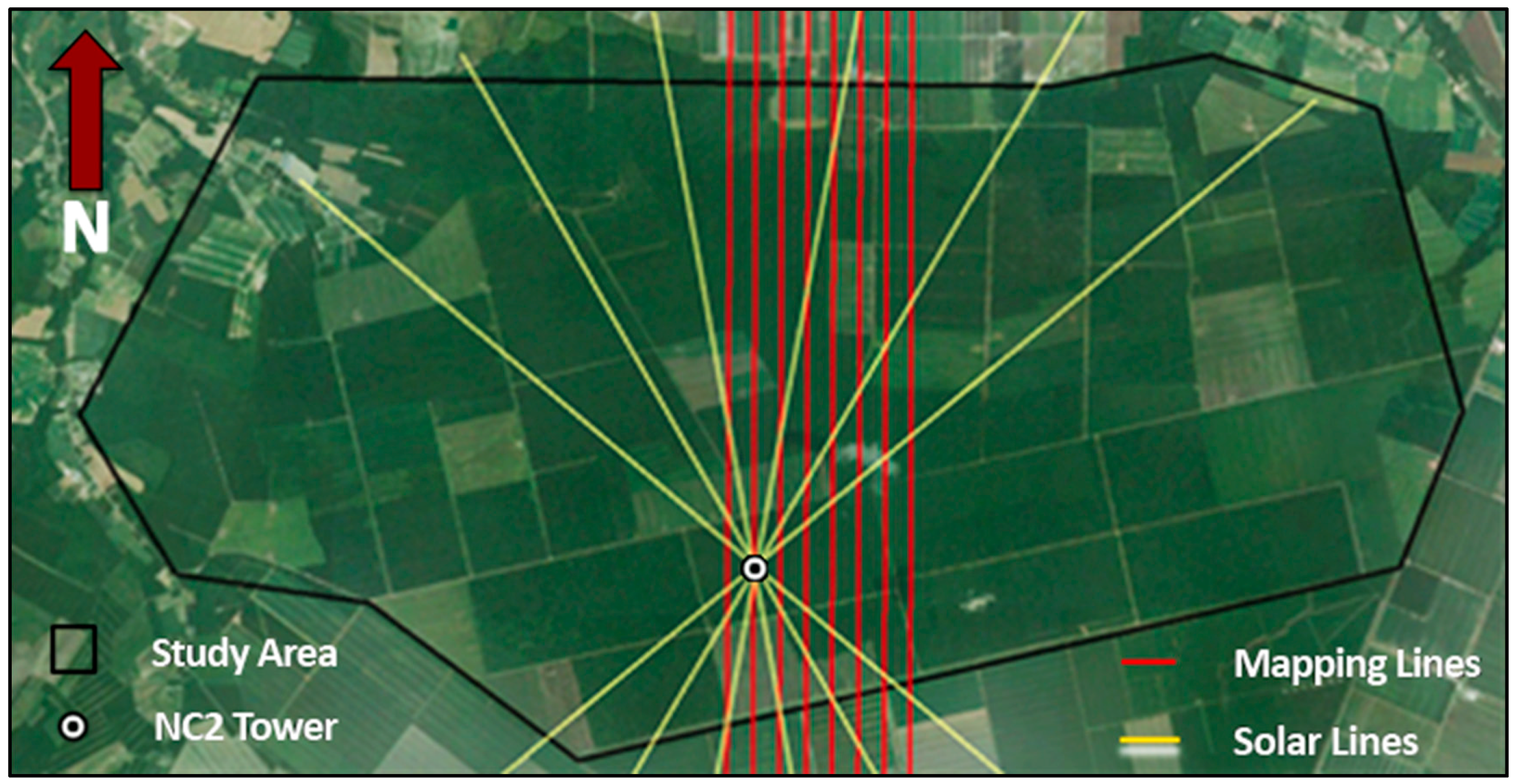

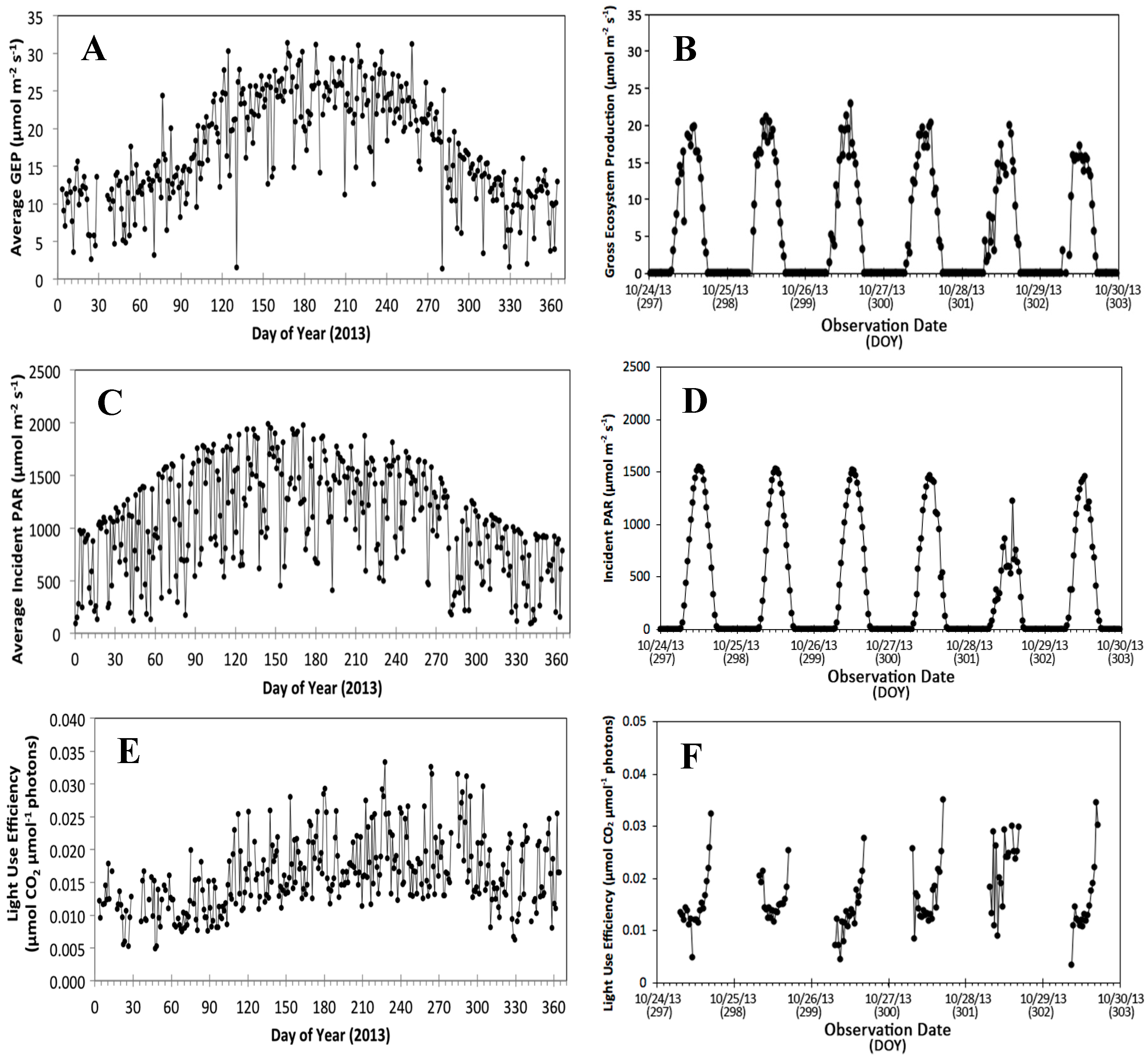
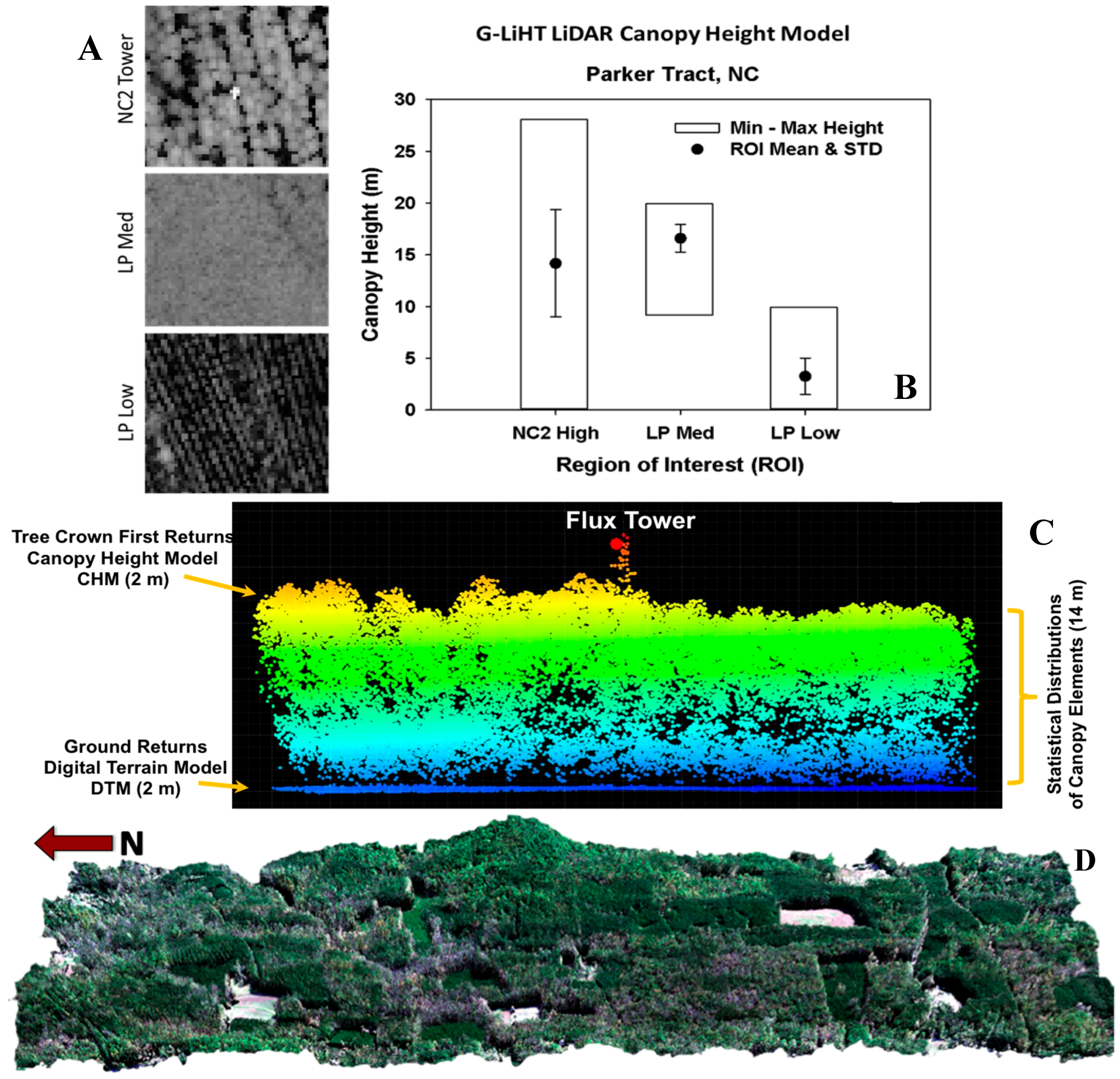

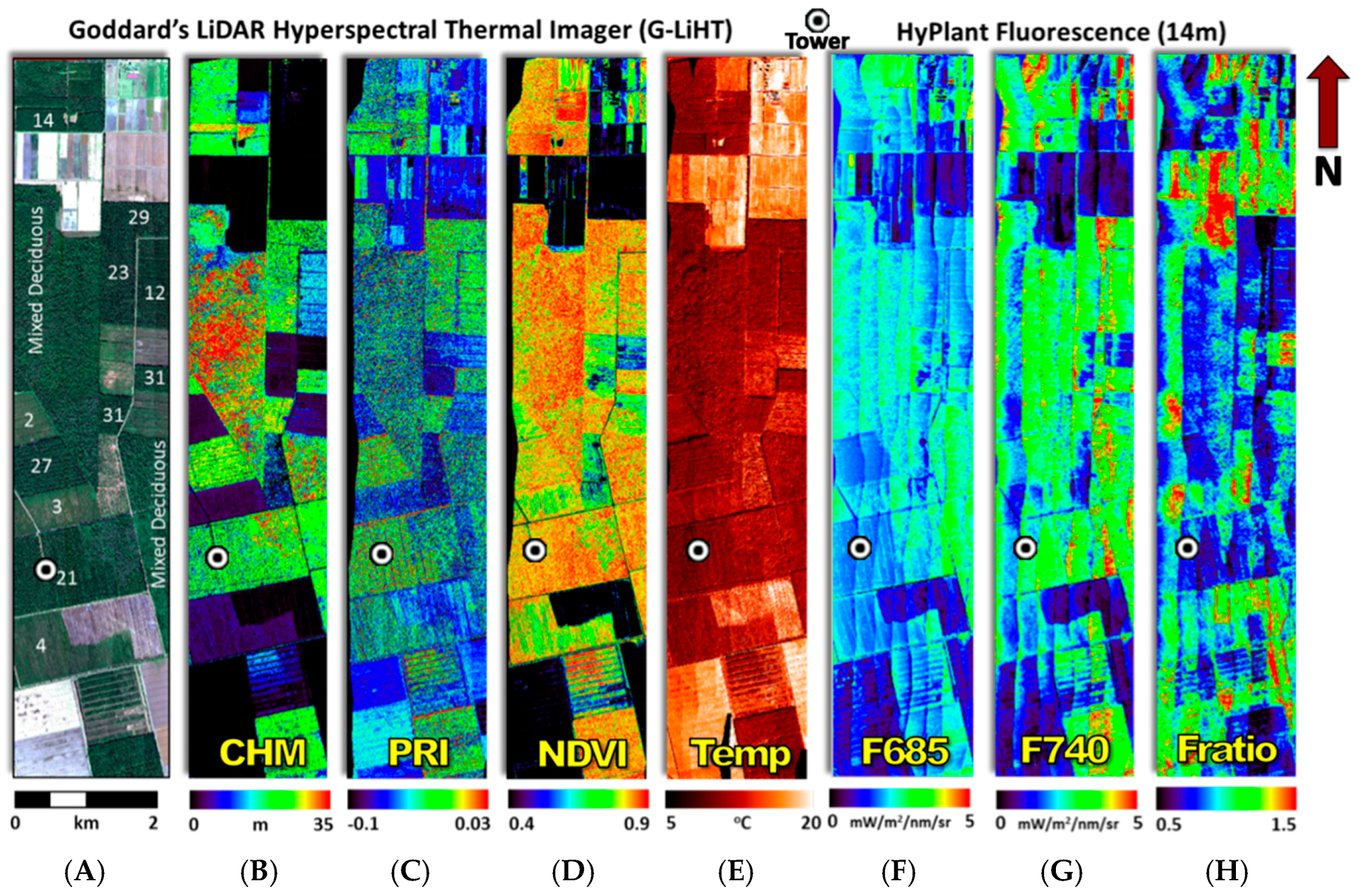
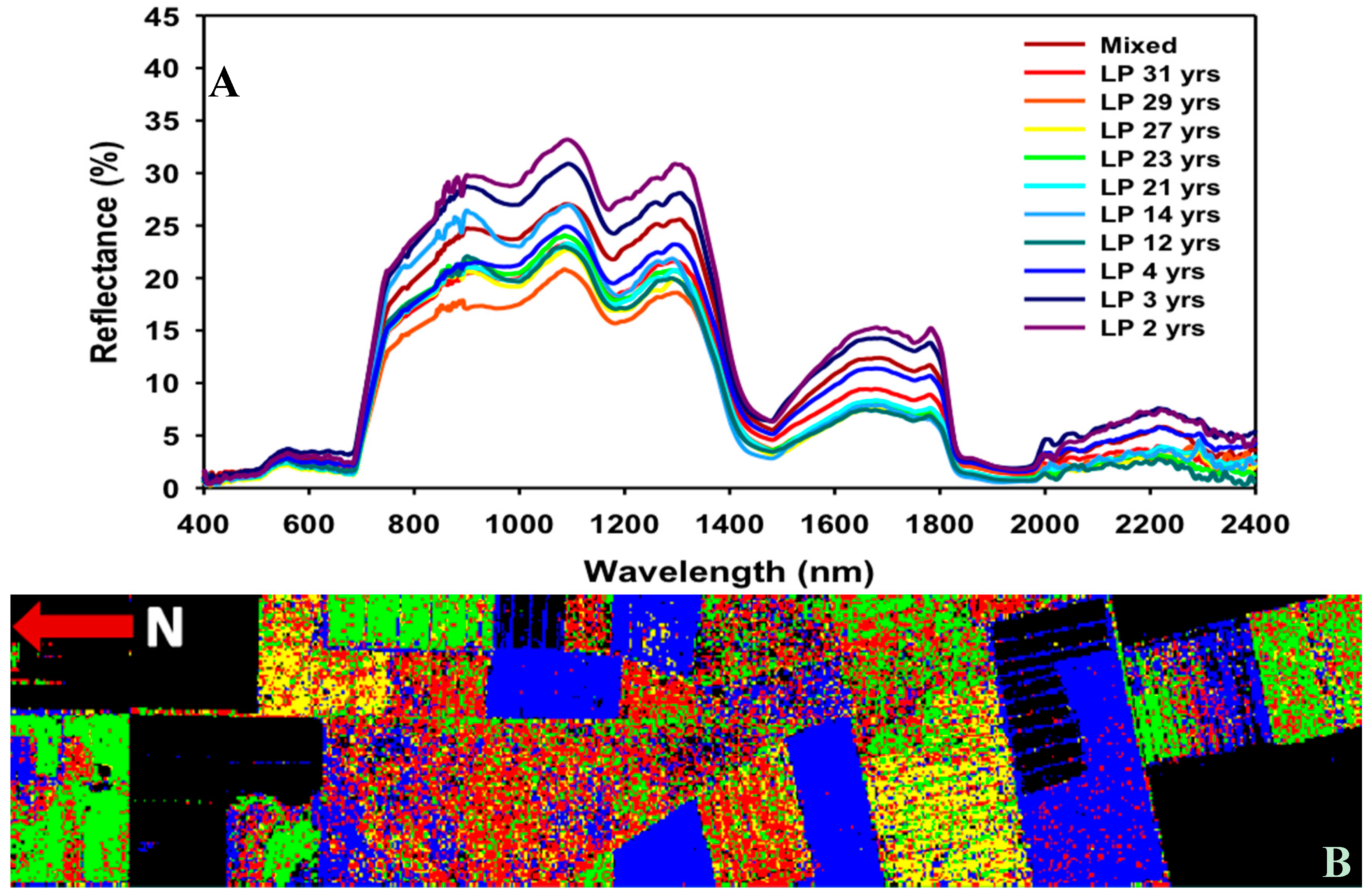
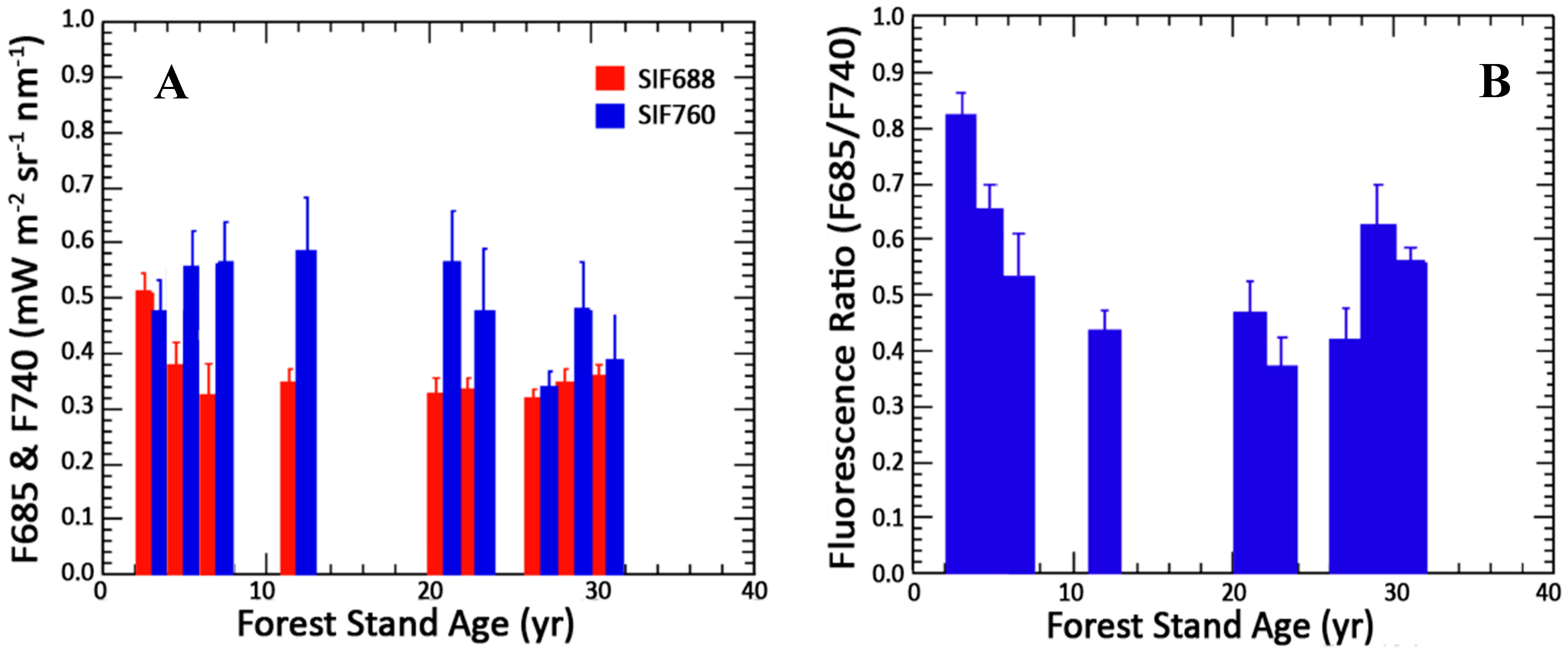

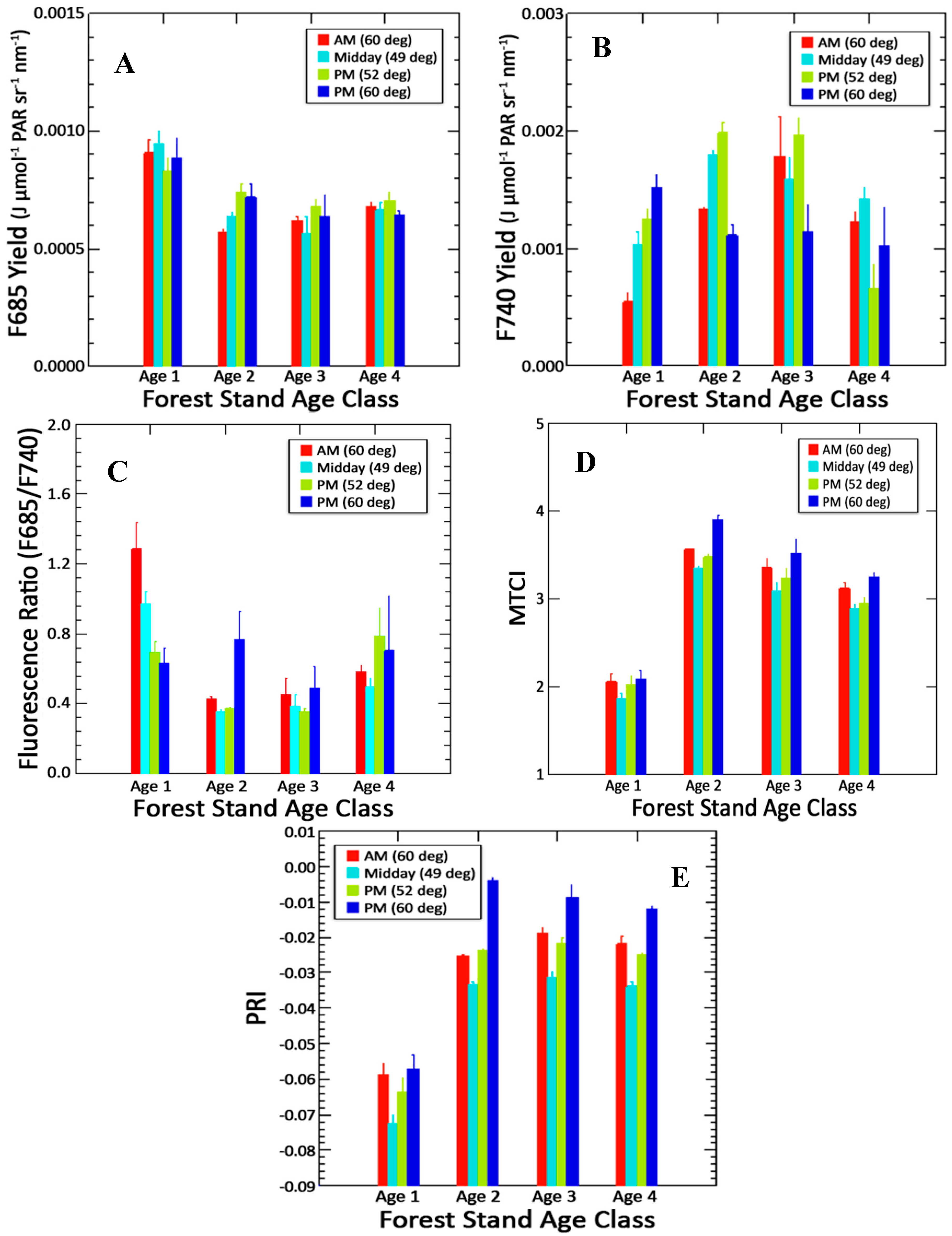
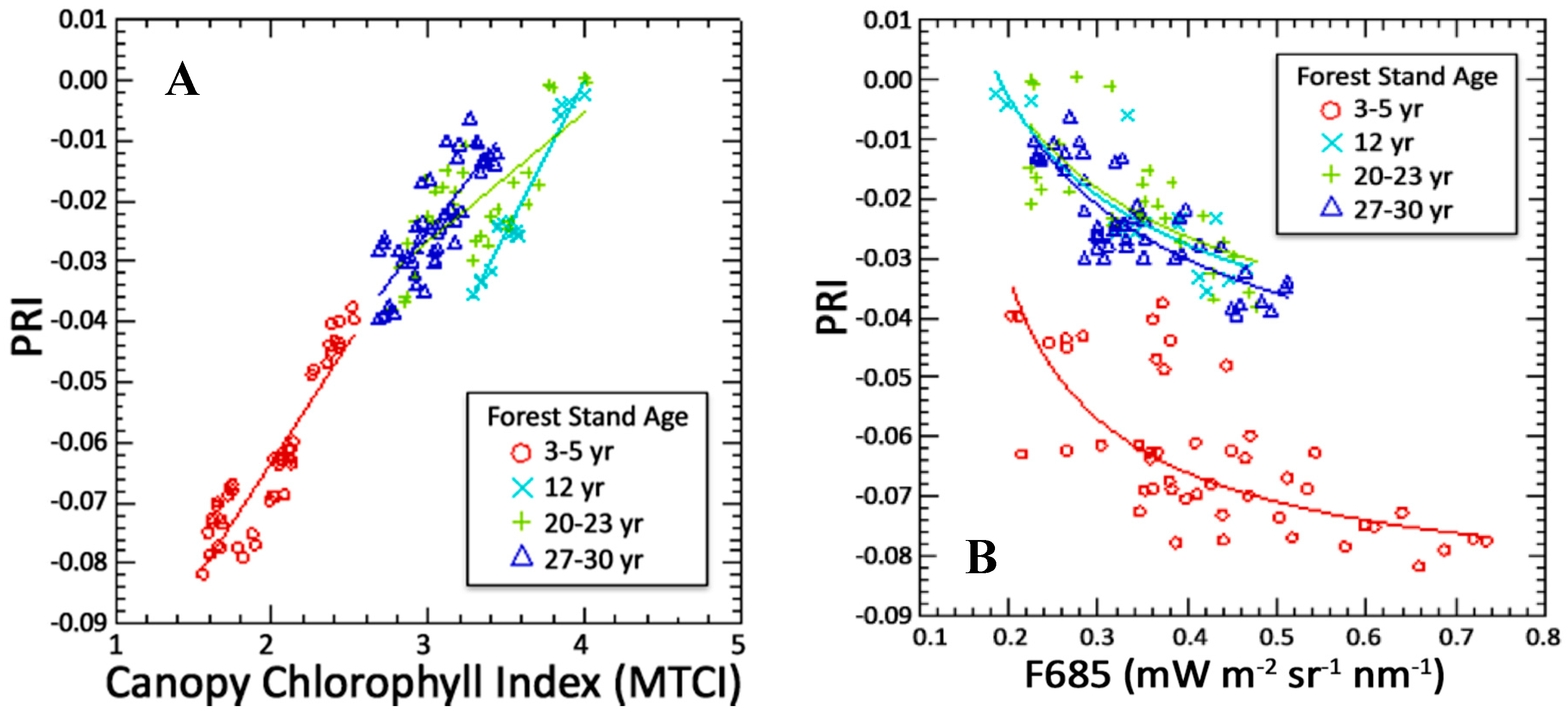
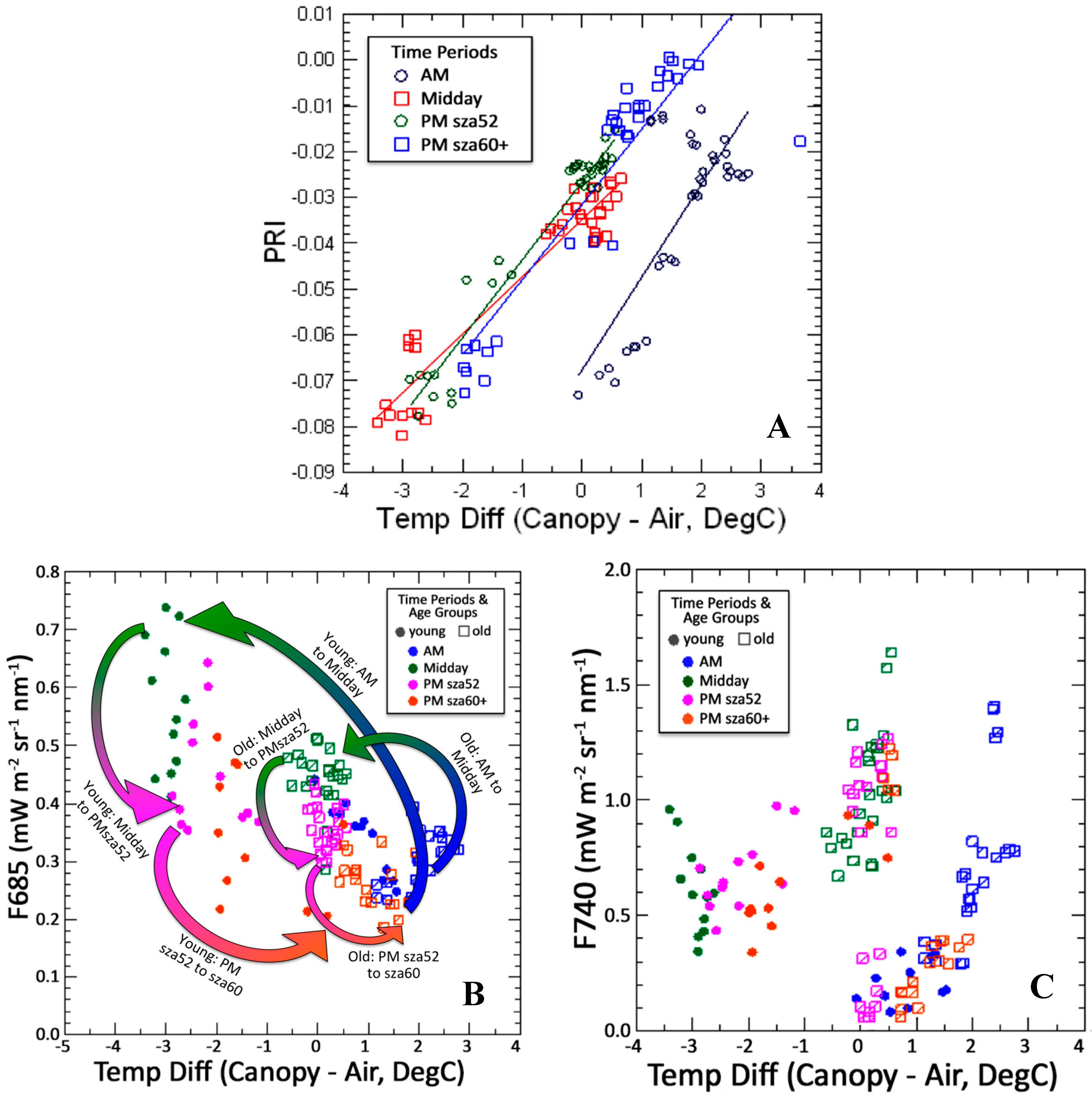
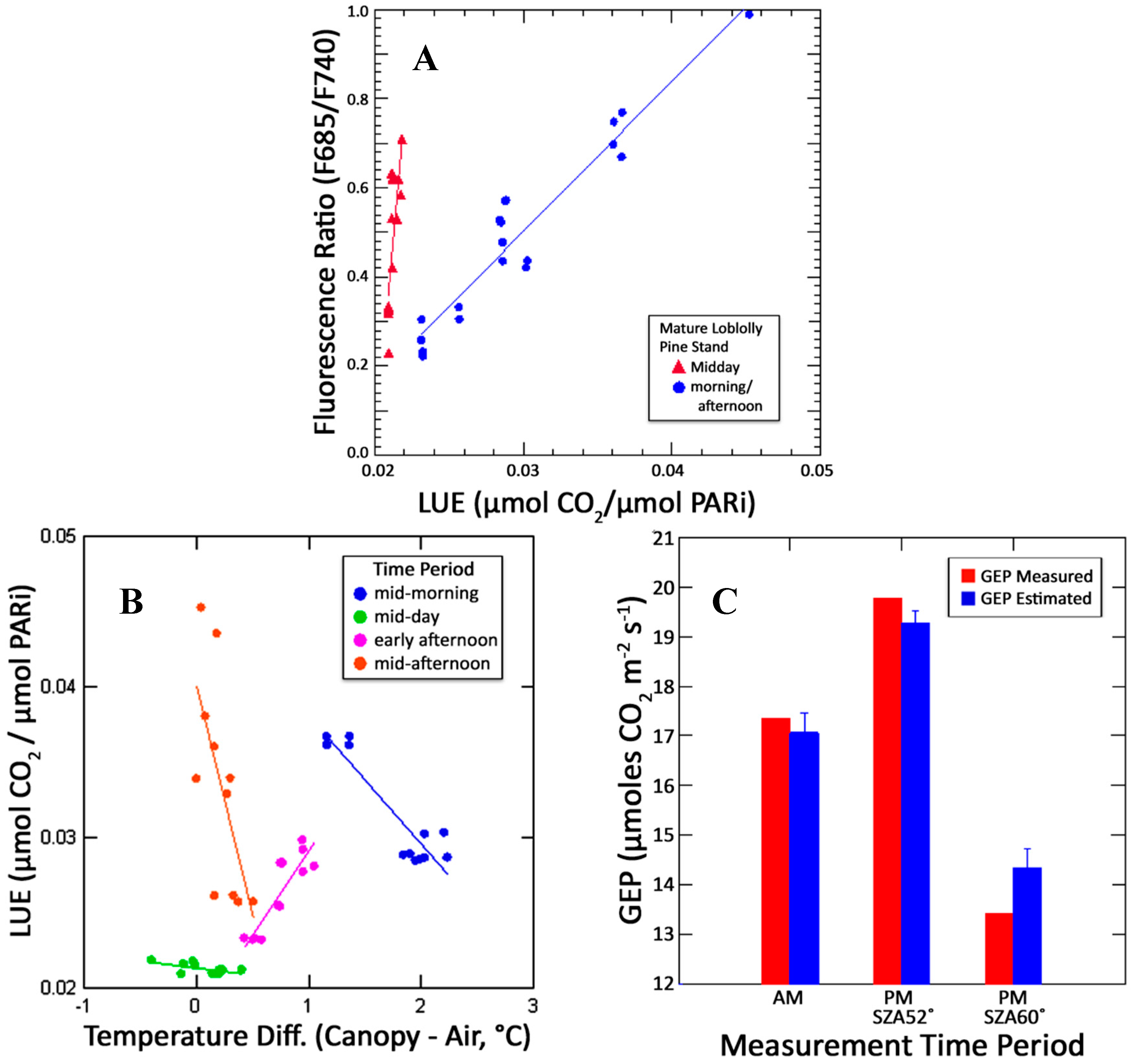

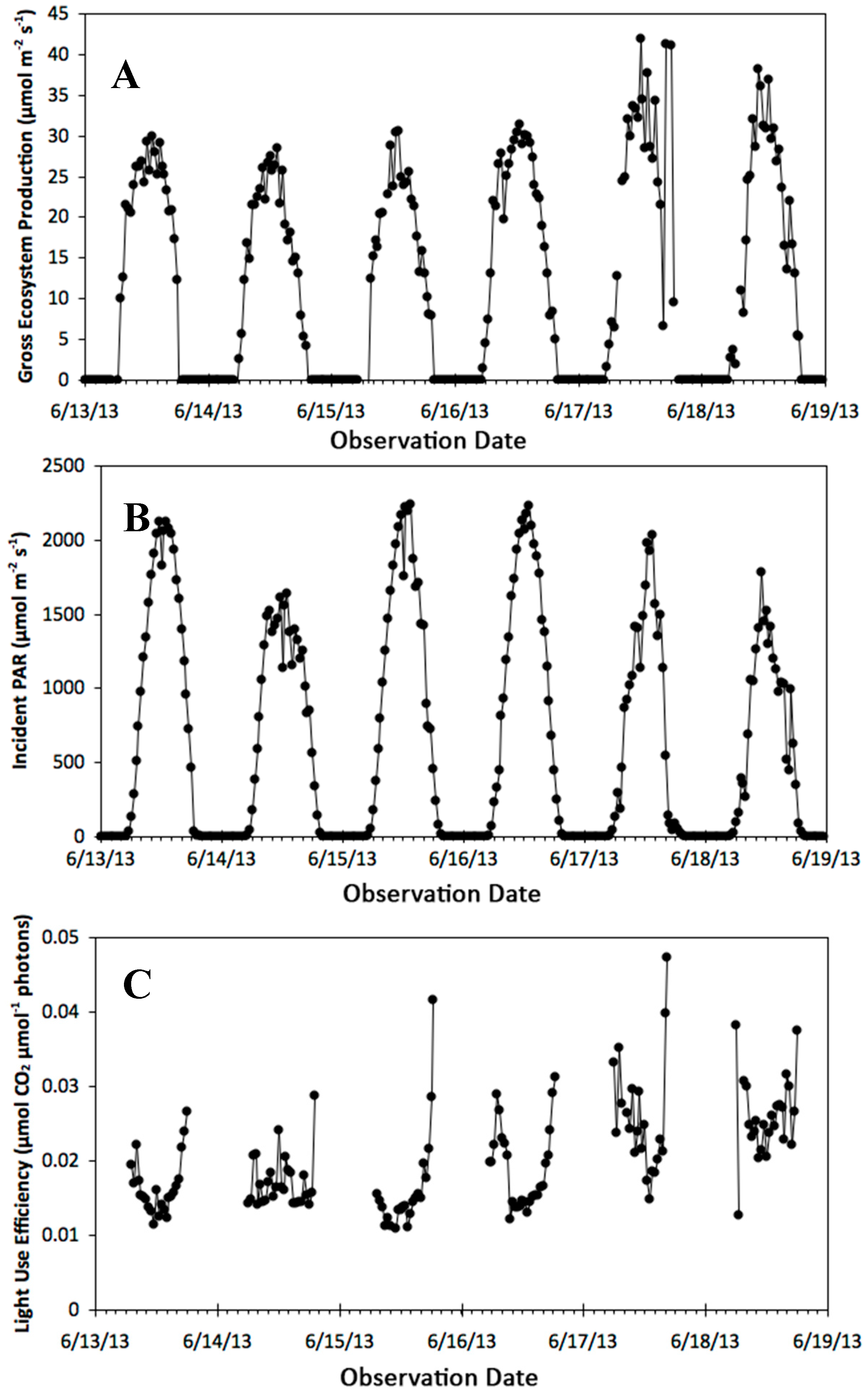
| Measurements and Data Collections | Parker Tract, NC (Pinus taeda) |
|---|---|
| Site location (degrees latitude, longitude) | 35.8031, −76.6679 |
| Mature Loblolly Site (US-NC2) | Canopy function (Gross Ecosystem Production): AmeriFlux Eddy covariance tower |
| Multiple Stands | |
| Field measurement dates | Continuous, 23 September to 27 October 2013 |
| Forest survey and GPS of measurements | VT, field guides/GPS |
| Vegetation height | VT, Clinometers |
| Leaf Area Index (LAI) | VT, LAI-2000 Plant canopy analyzers |
| Tree diameter at breast height, DBH | VT, Tree diameter at 1.30 m |
| Canopy (forest) density | VT, Within 1/10 acre plot, Prism |
| Stand age | VT, Field determination |
© 2017 by the authors. Licensee MDPI, Basel, Switzerland. This article is an open access article distributed under the terms and conditions of the Creative Commons Attribution (CC BY) license (http://creativecommons.org/licenses/by/4.0/).
Share and Cite
Middleton, E.M.; Rascher, U.; Corp, L.A.; Huemmrich, K.F.; Cook, B.D.; Noormets, A.; Schickling, A.; Pinto, F.; Alonso, L.; Damm, A.; et al. The 2013 FLEX—US Airborne Campaign at the Parker Tract Loblolly Pine Plantation in North Carolina, USA. Remote Sens. 2017, 9, 612. https://doi.org/10.3390/rs9060612
Middleton EM, Rascher U, Corp LA, Huemmrich KF, Cook BD, Noormets A, Schickling A, Pinto F, Alonso L, Damm A, et al. The 2013 FLEX—US Airborne Campaign at the Parker Tract Loblolly Pine Plantation in North Carolina, USA. Remote Sensing. 2017; 9(6):612. https://doi.org/10.3390/rs9060612
Chicago/Turabian StyleMiddleton, Elizabeth M., Uwe Rascher, Lawrence A. Corp, K. Fred Huemmrich, Bruce D. Cook, Asko Noormets, Anke Schickling, Francisco Pinto, Luis Alonso, Alexander Damm, and et al. 2017. "The 2013 FLEX—US Airborne Campaign at the Parker Tract Loblolly Pine Plantation in North Carolina, USA" Remote Sensing 9, no. 6: 612. https://doi.org/10.3390/rs9060612
APA StyleMiddleton, E. M., Rascher, U., Corp, L. A., Huemmrich, K. F., Cook, B. D., Noormets, A., Schickling, A., Pinto, F., Alonso, L., Damm, A., Guanter, L., Colombo, R., Campbell, P. K. E., Landis, D. R., Zhang, Q., Rossini, M., Schuettemeyer, D., & Bianchi, R. (2017). The 2013 FLEX—US Airborne Campaign at the Parker Tract Loblolly Pine Plantation in North Carolina, USA. Remote Sensing, 9(6), 612. https://doi.org/10.3390/rs9060612





